Guangming Shi
SANet: A Semantic-aware Agentic AI Networking Framework for Cross-layer Optimization in 6G
Dec 27, 2025Abstract:Agentic AI networking (AgentNet) is a novel AI-native networking paradigm in which a large number of specialized AI agents collaborate to perform autonomous decision-making, dynamic environmental adaptation, and complex missions. It has the potential to facilitate real-time network management and optimization functions, including self-configuration, self-optimization, and self-adaptation across diverse and complex environments. This paper proposes SANet, a novel semantic-aware AgentNet architecture for wireless networks that can infer the semantic goal of the user and automatically assign agents associated with different layers of the network to fulfill the inferred goal. Motivated by the fact that AgentNet is a decentralized framework in which collaborating agents may generally have different and even conflicting objectives, we formulate the decentralized optimization of SANet as a multi-agent multi-objective problem, and focus on finding the Pareto-optimal solution for agents with distinct and potentially conflicting objectives. We propose three novel metrics for evaluating SANet. Furthermore, we develop a model partition and sharing (MoPS) framework in which large models, e.g., deep learning models, of different agents can be partitioned into shared and agent-specific parts that are jointly constructed and deployed according to agents' local computational resources. Two decentralized optimization algorithms are proposed. We derive theoretical bounds and prove that there exists a three-way tradeoff among optimization, generalization, and conflicting errors. We develop an open-source RAN and core network-based hardware prototype that implements agents to interact with three different layers of the network. Experimental results show that the proposed framework achieved performance gains of up to 14.61% while requiring only 44.37% of FLOPs required by state-of-the-art algorithms.
NOC4SC: A Bandwidth-Efficient Multi-User Semantic Communication Framework for Interference-Resilient Transmission
Dec 10, 2025Abstract:With the explosive growth of connected devices and emerging applications, current wireless networks are encountering unprecedented demands for massive user access, where the inter-user interference has become a critical challenge to maintaining high quality of service (QoS) in multi-user communication systems. To tackle this issue, we propose a bandwidth-efficient semantic communication paradigm termed Non-Orthogonal Codewords for Semantic Communication (NOC4SC), which enables simultaneous same-frequency transmission without spectrum spreading. By leveraging the Swin Transformer, the proposed NOC4SC framework enables each user to independently extract semantic features through a unified encoder-decoder architecture with shared network parameters across all users, which ensures that the user's data remains protected from unauthorized decoding. Furthermore, we introduce an adaptive NOC and SNR Modulation (NSM) block, which employs deep learning to dynamically regulate SNR and generate approximately orthogonal semantic features within distinct feature subspaces, thereby effectively mitigating inter-user interference. Extensive experiments demonstrate the proposed NOC4SC achieves comparable performance to the DeepJSCC-PNOMA and outperforms other multi-user SemCom baseline methods.
SITP: A High-Reliability Semantic Information Transport Protocol Without Retransmission for Semantic Communication
Dec 10, 2025Abstract:With the evolution of 6G networks, modern communication systems are facing unprecedented demands for high reliability and low latency. However, conventional transport protocols are designed for bit-level reliability, failing to meet the semantic robustness requirements. To address this limitation, this paper proposes a novel Semantic Information Transport Protocol (SITP), which achieves TCP-level reliability and UDP level latency by verifying only packet headers while retaining potentially corrupted payloads for semantic decoding. Building upon SITP, a cross-layer analytical model is established to quantify packet-loss probability across the physical, data-link, network, transport, and application layers. The model provides a unified probabilistic formulation linking signal noise rate (SNR) and packet-loss rate, offering theoretical foundation into end-to-end semantic transmission. Furthermore, a cross-image feature interleaving mechanism is developed to mitigate consecutive burst losses by redistributing semantic features across multiple correlated images, thereby enhancing robustness in burst-fade channels. Extensive experiments show that SITP offers lower latency than TCP with comparable reliability at low SNRs, while matching UDP-level latency and delivering superior reconstruction quality. In addition, the proposed cross-image semantic interleaving mechanism further demonstrates its effectiveness in mitigating degradation caused by bursty packet losses.
Parse Graph-Based Visual-Language Interaction for Human Pose Estimation
Sep 09, 2025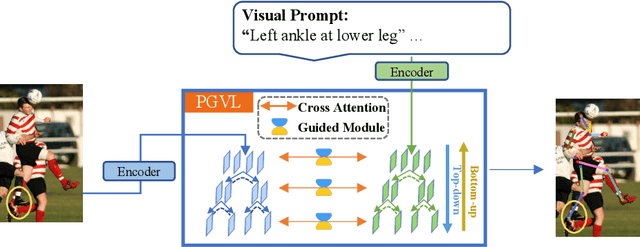

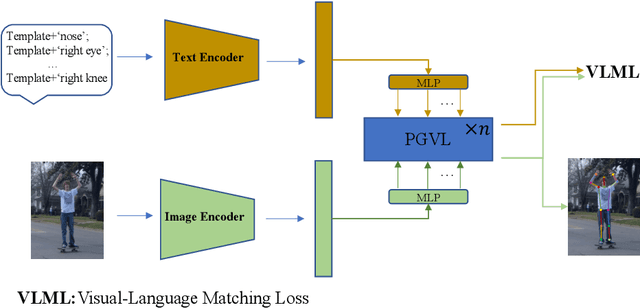

Abstract:Parse graphs boost human pose estimation (HPE) by integrating context and hierarchies, yet prior work mostly focuses on single modality modeling, ignoring the potential of multimodal fusion. Notably, language offers rich HPE priors like spatial relations for occluded scenes, but existing visual-language fusion via global feature integration weakens occluded region responses and causes alignment and location failures. To address this issue, we propose Parse Graph-based Visual-Language interaction (PGVL) with a core novel Guided Module (GM). In PGVL, low-level nodes focus on local features, maximizing the maintenance of responses in occluded areas and high-level nodes integrate global features to infer occluded or invisible parts. GM enables high semantic nodes to guide the feature update of low semantic nodes that have undergone cross attention. It ensuring effective fusion of diverse information. PGVL includes top-down decomposition and bottom-up composition. In the first stage, modality specific parse graphs are constructed. Next stage. recursive bidirectional cross-attention is used, purified by GM. We also design network based on PGVL. The PGVL and our network is validated on major pose estimation datasets. We will release the code soon.
Optimizing Multi-Modal Trackers via Sensitivity-aware Regularized Tuning
Aug 24, 2025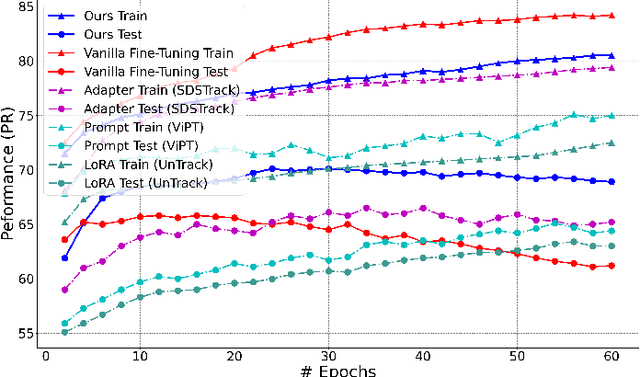
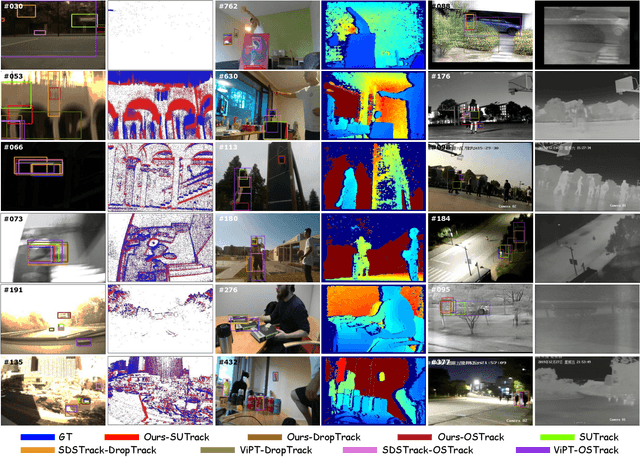
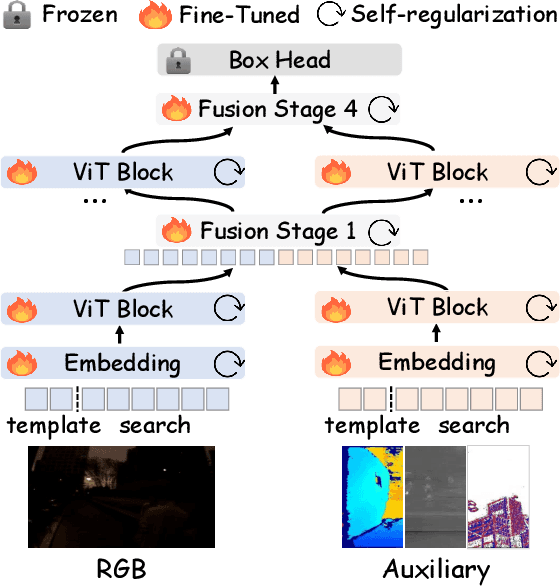
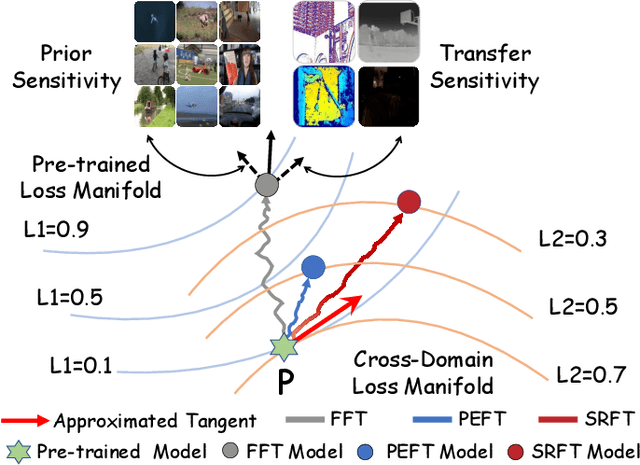
Abstract:This paper tackles the critical challenge of optimizing multi-modal trackers by effectively adapting the pre-trained models for RGB data. Existing fine-tuning paradigms oscillate between excessive freedom and over-restriction, both leading to a suboptimal plasticity-stability trade-off. To mitigate this dilemma, we propose a novel sensitivity-aware regularized tuning framework, which delicately refines the learning process by incorporating intrinsic parameter sensitivities. Through a comprehensive investigation from pre-trained to multi-modal contexts, we identify that parameters sensitive to pivotal foundational patterns and cross-domain shifts are primary drivers of this issue. Specifically, we first analyze the tangent space of pre-trained weights to measure and orient prior sensitivities, dedicated to preserving generalization. Then, we further explore transfer sensitivities during the tuning phase, emphasizing adaptability and stability. By incorporating these sensitivities as regularization terms, our method significantly enhances the transferability across modalities. Extensive experiments showcase the superior performance of the proposed method, surpassing current state-of-the-art techniques across various multi-modal tracking. The source code and models will be publicly available at https://github.com/zhiwen-xdu/SRTrack.
SeqAffordSplat: Scene-level Sequential Affordance Reasoning on 3D Gaussian Splatting
Jul 31, 2025Abstract:3D affordance reasoning, the task of associating human instructions with the functional regions of 3D objects, is a critical capability for embodied agents. Current methods based on 3D Gaussian Splatting (3DGS) are fundamentally limited to single-object, single-step interactions, a paradigm that falls short of addressing the long-horizon, multi-object tasks required for complex real-world applications. To bridge this gap, we introduce the novel task of Sequential 3D Gaussian Affordance Reasoning and establish SeqAffordSplat, a large-scale benchmark featuring 1800+ scenes to support research on long-horizon affordance understanding in complex 3DGS environments. We then propose SeqSplatNet, an end-to-end framework that directly maps an instruction to a sequence of 3D affordance masks. SeqSplatNet employs a large language model that autoregressively generates text interleaved with special segmentation tokens, guiding a conditional decoder to produce the corresponding 3D mask. To handle complex scene geometry, we introduce a pre-training strategy, Conditional Geometric Reconstruction, where the model learns to reconstruct complete affordance region masks from known geometric observations, thereby building a robust geometric prior. Furthermore, to resolve semantic ambiguities, we design a feature injection mechanism that lifts rich semantic features from 2D Vision Foundation Models (VFM) and fuses them into the 3D decoder at multiple scales. Extensive experiments demonstrate that our method sets a new state-of-the-art on our challenging benchmark, effectively advancing affordance reasoning from single-step interactions to complex, sequential tasks at the scene level.
KB-DMGen: Knowledge-Based Global Guidance and Dynamic Pose Masking for Human Image Generation
Jul 26, 2025Abstract:Recent methods using diffusion models have made significant progress in human image generation with various control signals such as pose priors. In portrait generation, both the accuracy of human pose and the overall visual quality are crucial for realistic synthesis. Most existing methods focus on controlling the accuracy of generated poses, but ignore the quality assurance of the entire image. In order to ensure the global image quality and pose accuracy, we propose Knowledge-Based Global Guidance and Dynamic pose Masking for human image Generation (KB-DMGen). The Knowledge Base (KB) is designed not only to enhance pose accuracy but also to leverage image feature information to maintain overall image quality. Dynamic Masking (DM) dynamically adjusts the importance of pose-related regions. Experiments demonstrate the effectiveness of our model, achieving new state-of-the-art results in terms of AP and CAP on the HumanArt dataset. The code will be made publicly available.
Controlled Data Rebalancing in Multi-Task Learning for Real-World Image Super-Resolution
Jun 05, 2025Abstract:Real-world image super-resolution (Real-SR) is a challenging problem due to the complex degradation patterns in low-resolution images. Unlike approaches that assume a broadly encompassing degradation space, we focus specifically on achieving an optimal balance in how SR networks handle different degradation patterns within a fixed degradation space. We propose an improved paradigm that frames Real-SR as a data-heterogeneous multi-task learning problem, our work addresses task imbalance in the paradigm through coordinated advancements in task definition, imbalance quantification, and adaptive data rebalancing. Specifically, we introduce a novel task definition framework that segments the degradation space by setting parameter-specific boundaries for degradation operators, effectively reducing the task quantity while maintaining task discrimination. We then develop a focal loss based multi-task weighting mechanism that precisely quantifies task imbalance dynamics during model training. Furthermore, to prevent sporadic outlier samples from dominating the gradient optimization of the shared multi-task SR model, we strategically convert the quantified task imbalance into controlled data rebalancing through deliberate regulation of task-specific training volumes. Extensive quantitative and qualitative experiments demonstrate that our method achieves consistent superiority across all degradation tasks.
SANNet: A Semantic-Aware Agentic AI Networking Framework for Multi-Agent Cross-Layer Coordination
May 25, 2025Abstract:Agentic AI networking (AgentNet) is a novel AI-native networking paradigm that relies on a large number of specialized AI agents to collaborate and coordinate for autonomous decision-making, dynamic environmental adaptation, and complex goal achievement. It has the potential to facilitate real-time network management alongside capabilities for self-configuration, self-optimization, and self-adaptation across diverse and complex networking environments, laying the foundation for fully autonomous networking systems in the future. Despite its promise, AgentNet is still in the early stage of development, and there still lacks an effective networking framework to support automatic goal discovery and multi-agent self-orchestration and task assignment. This paper proposes SANNet, a novel semantic-aware agentic AI networking architecture that can infer the semantic goal of the user and automatically assign agents associated with different layers of a mobile system to fulfill the inferred goal. Motivated by the fact that one of the major challenges in AgentNet is that different agents may have different and even conflicting objectives when collaborating for certain goals, we introduce a dynamic weighting-based conflict-resolving mechanism to address this issue. We prove that SANNet can provide theoretical guarantee in both conflict-resolving and model generalization performance for multi-agent collaboration in dynamic environment. We develop a hardware prototype of SANNet based on the open RAN and 5GS core platform. Our experimental results show that SANNet can significantly improve the performance of multi-agent networking systems, even when agents with conflicting objectives are selected to collaborate for the same goal.
Modeling and Performance Analysis for Semantic Communications Based on Empirical Results
Apr 29, 2025
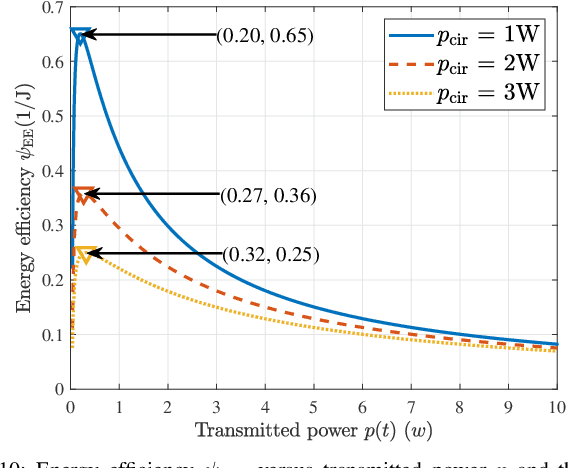

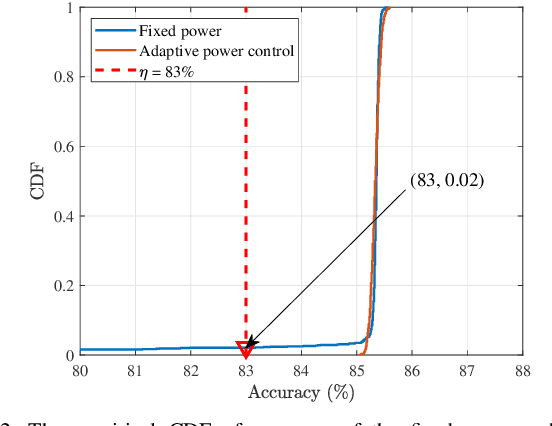
Abstract:Due to the black-box characteristics of deep learning based semantic encoders and decoders, finding a tractable method for the performance analysis of semantic communications is a challenging problem. In this paper, we propose an Alpha-Beta-Gamma (ABG) formula to model the relationship between the end-to-end measurement and SNR, which can be applied for both image reconstruction tasks and inference tasks. Specifically, for image reconstruction tasks, the proposed ABG formula can well fit the commonly used DL networks, such as SCUNet, and Vision Transformer, for semantic encoding with the multi scale-structural similarity index measure (MS-SSIM) measurement. Furthermore, we find that the upper bound of the MS-SSIM depends on the number of quantized output bits of semantic encoders, and we also propose a closed-form expression to fit the relationship between the MS-SSIM and quantized output bits. To the best of our knowledge, this is the first theoretical expression between end-to-end performance metrics and SNR for semantic communications. Based on the proposed ABG formula, we investigate an adaptive power control scheme for semantic communications over random fading channels, which can effectively guarantee quality of service (QoS) for semantic communications, and then design the optimal power allocation scheme to maximize the energy efficiency of the semantic communication system. Furthermore, by exploiting the bisection algorithm, we develop the power allocation scheme to maximize the minimum QoS of multiple users for OFDMA downlink semantic communication Extensive simulations verify the effectiveness and superiority of the proposed ABG formula and power allocation schemes.
 Add to Chrome
Add to Chrome Add to Firefox
Add to Firefox Add to Edge
Add to Edge